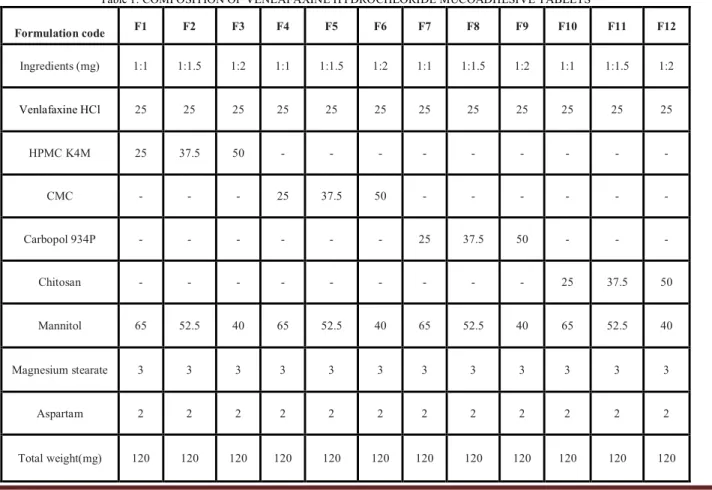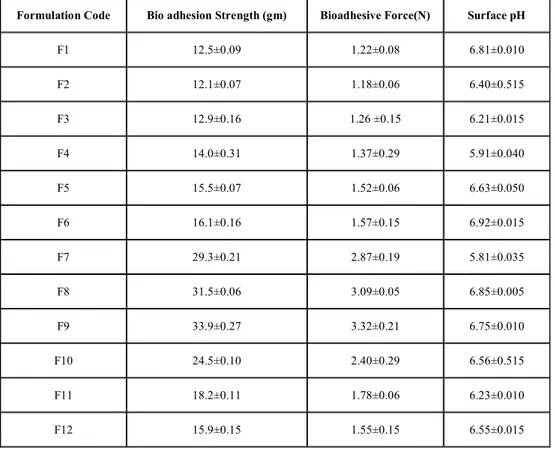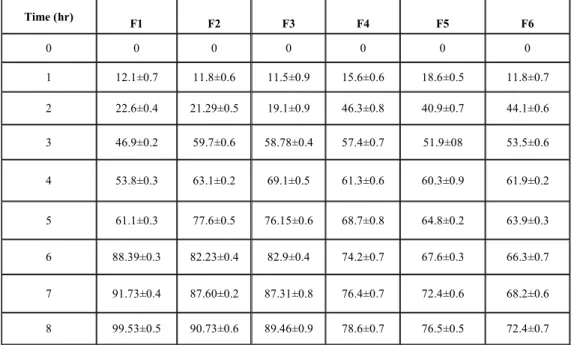INTERNATIONAL RESEARCH JOURNAL OF PHARMACY
www.irjponline.com
ISSN 2230
–
8407
Research Article
FORMULATION AND EVALUATION OF VENLAFAXINE HYDROCHLORIDE
MUCOADHESIVE BUCCAL TABLETS
Inampudi Ajit*, Adimoolam Senthil, Bhosale Rahul, Vantoor Byrappa Narayana swamy
Department of Pharmaceutics, Karavali College of Pharmacy, Mangalore-575028, Karnataka, India
Article Received on: 17/11/11 Revised on: 19/12/11 Approved for publication: 06/01/12
*Email: ajithyderabad@gmail.com
ABSTRACT
The present study involves the formulation and evaluation of buccal tablets of venlafaxine hydrochloride, an antidepressant drug to circumvent the first pass metabolism. Buccal route is excellent for the systemic delivery, there by rendering great bioavailability. A significant reduction in dose and dosing frequency can be achieved, thereby reducing dose dependent side effects, patient compliance and prolonging duration of action. Tablets of venlafaxine HCl were prepared by direct compression method. Twelve formulations were prepared with varying concentrations of bioadhesive polymers like hydroxypropylmethylcellulose K4M (HPMC K4M), carboxymethylcellulose (CMC), carbopol 934P and chitosan. Buccal tablets were evaluated by different parameters such as thickness, hardness, weight uniformity, content uniformity, swelling index, surface pH, ex vivo bioadhesive strength, in vitro drug release, ex vivo drug permeation and FTIR studies. The modified in vitro assembly was used to measure the bioadhesive strength of tablets with fresh porcine buccal mucosa as model tissue. The tablets were evaluated for in vitro release in pH 6.8 phosphate buffer for 8 hours in standard dissolution apparatus in order to determine the mode of release, the data was subjected to model fitting, the optimized formula followed non-fickian release mechanism with zero order kinetics. The formulation containing venlafaxine HCl and HPMC K4M in the ratio of 1:1 could be used to design effective and stable buccoadhesive tablets of venlafaxine HCl.
KEYWORDS: Buccal tablets, Venlafaxine hydrochloride, Swelling index, Mucoadhesive.
INTRODUCTION
The oral cavity is an attractive site for drug delivery due to ease of administration, avoidance of possible drug degradation in the gastrointestinal tract and first-pass metabolism. Buccal delivery system involves the administration of the desired drug through the buccal mucosal membrane lining of the oral cavity. Prolonged release of the drug and increased bioavailability leads to the significant reduction in the dose and dose related side effects. Moreover buccal drug absorption can be promptly terminated in case of toxicity by removing the dosage from the buccal cavity therefore mucoadhesive dosage forms were suggested for oral drug delivery which includes various mucoadhesive devices such as patches1, tablets, films, gels, disc2, strips and ointment3. Venlafaxine hydrochloride is selective serotonin reuptake inhibitor used in the treatment of depression; it was selected as model drug for investigation because of its suitable properties like dose (25 mg), half life of 5 hours and molecular weight (277.40). A suitable buccal drug delivery system should possess good bioadhesive properties, so that it can be retained in oral cavity for the desired duration. In present study, the mucoadhesive tablets were developed using polymers such as HPMC K4M, CMC, carbopol 934P and chitosan to get controlled and zero order drug release4,5.
MATERIALS AND METHODS Materials
Venlafaxine hydrochloride was gift sample from Lupin pharmaceuticals, Pune, India. Carbopol 934P, hydroxypropylmethylcellulose (HPMC K4M), chitosan and CMC from Zydus Cadila, India. Mannitol and Aspartane by Dr Reddy's laboratories, Hyderabad, India.
Mucoadhesive Tablets Preparation
Buccal tablets were prepared by a direct compression method. Venlafaxine hydrochloride was mixed manually with different ratios of HPMC K4M, CMC, carbopol 934P, chitosan, and mannitol as diluent for 10 min. The blend was
lubricated with magnesium stearate for 3 to 5 min. The mixture is compressed using 8 mm flat faced punch on Cemach 12 stages rotary tablet compression machine. Compositions of formulations were given in Table 1.
Evaluation of buccal tablets Thickness
The thickness of buccal tablets was determined using digital micrometer. Ten tablets from each batch were evaluated and the results averaged.
Weight variation
Weight variation was performed for twenty tablets from each batch using an electronic balance and average values were calculated.
Hardness
Hardness was conducted for three tablets from each batch using Monsanto hardness tester and average values were calculated7,8.
Friability
Friability test was conducted by testing twenty tablets from each batch, using Roche friabilator.
Content uniformity
Ten tablets were weighed and grounded in a mortar with pestle to get fine powder; powder equivalent to the mass of one tablet was dissolved in methanol by sonication for 30 min and filtered through filter paper. The drug content was analyzed spectrophotometrically at 224 nm using an UV spectrophotometer.
Measurement of bioadhesion strength
accommodate a glass container of 6.6 cm height. All parts of modified physical balance. In order to find out the bioadhesion strength first buccal tablet (n=3) was stacked to the glass slide with the help of knob, which was situated at the base of physical balance. Now five grams weight from the right pan was then removed. This lowered the glass slide along with the tablet over the membrane with a weight of 5.0 g. This was kept undisturbed for 5 min. Then the weights on the right-hand side were slowly added in increments of 0.1 g till the tablet just separated from the membrane surface. The excess weight on the right pan, i.e. total weight minus 5 g was taken as a measure of the bioadhesive strength10.
Surface pH Study
Buccoadhesive tablets were allowed to swell for 2 hours on the surface of agar plate. The surface pH was measured by means of a pH paper placed on the core surface of the swollen tablet. A mean of three readings was recorded11.
Swelling Studies
Buccal tablets were weighed individually (designated as W1) and placed separately in Petri dishes containing 15 ml of phosphate buffer (pH 6.8) solution. At regular intervals (1, 2, 3, 4, 5, 6, 7 and 8 hrs), the buccal tablets were removed from the Petri dishes and excess surface water was removed carefully using the filter paper. The swollen tablets were then reweighed (W2). This experiment was performed in triplicate. The swelling index (water uptake) calculated according to thefollowing Equation5,12.
Swelling index= [(W2-W1)/W1] In vitrodrug release of buccal tablets
The United States Pharmacopeia (USP) II rotating paddle method was used to study the drug release from the buccal tablets. The dissolution medium consisted of 500 ml of phosphate buffer pH 6.8. The release was performed at 37oC + 0.5oC, with a rotation speed of 50 rpm. The backing layer of buccal tablet was attached to the glass slide with instant adhesive (cyanoacrylate adhesive). The slide was placed in to the bottom of the dissolution vessel. Samples (5 ml) were withdrawn at predetermined time intervals and replaced with fresh medium. Dissolution for the conventional marketed product was conducted without glass slide. The samples were filtered through filter paper and analyzed after appropriate dilution by UV spectrophotometer at 224 nm.
Release kinetics and mechanism
To know the release mechanism and kinetics of venlafaxine HCl, optimized formulation was attempted to fit in to mathematical models and n, r2 values for zero order, First order, Higuchi and Peppas models were represented in Table 6 .The peppas model is widely used, when the release mechanism is not well known or more than one type of release could be involved. The semi-empirical equation13 was shown as equation.
Mt/M∞ = ktn
Where, Mt/M∞ is fraction of drug released at time‘t’, k represents a constant, and n is the diffusional exponent, which characterizes the type of release mechanism during the dissolution process. For non-fickian release, the value of n falls between 0.5 and 1.0; while in case of fickian diffusion, n = 0.5; for zero-order release (case II transport), n = 1; and for supercase II transport, n > 1. Observation of all the r2 values indicated that the highest r2 (value was found forZero order release. According to ‘n’ value it is one, so it follows non-fickian diffusion with zero order release (caseII transport).
Ex vivopermeation of drug solution
Ex vivo permeation study of venlafaxine HCl through the porcine buccal mucosa was performedusing dissolution cell and membrane assembly, at 37°C +0.2°C and 50 rpm. This temperature and rpm was maintained by magnetic stirrer.
Porcine buccal mucosa was obtained from a local
slaughterhouse and used within 2 hours of slaughter. The tissue was stored in Krebs buffer at4°C upon collection. The epithelium was separated fromunderlying connective tissues with surgical scissors and tied to the one side of open tube. The membrane containside of the tube (donor chamber) was brought in to contact with the surface of the 50 ml pH 6.8 buffer solution15 which wastaken in 100 ml beaker (receiver chamber). After thebuccal membrane was equilibrated for 30 min with thebuffer solution between both the chambers, the receiver chamber was filled with fresh buffer solution (pH 7.4) and the donor chamber was charged with 5 ml (1mg/ml) of drug solution. Aliquots (5 ml) were collected at predetermined time inter wells up to 8 hours and the amount of drug permeated through the buccal mucosa was then determined by measuring the absorbance at 224 nm using a UV spectrophotometer. The medium of the same volume(5 ml), which was pre warmed at 37°C, was then replacedinto the receiver chamber. The experiments were performed in triplicate (n = 3) and meanvalues were used to calculate flux (J) and permeabilitycoefficient (P).
J = (dQ/dt) A P = (dQ/dt)
ΔCA
J is Flux (mg.hrs-1cm-2); P is permeability coefficient (cm/hr); dQ/dt is the slope; SC, the concentrationdifference across the mucosa and A the area of diffusion(cm2).
Fourier transform infrared spectroscopic studies
FTIR spectroscopic studies were conducted for optimized formulation and venlafaxine HCl pure drug.
RESULTS AND DISCUSSION
varies with characteristics and composition of polymers. The release rate of drug decreased with increasing concentration of HPMC K4M and chitosan respectively. The ability of HPMC to form complex matrix network which leads to delay in release of drug from the device. The maximum cumulative percent release of venlafaxine HCl from formulation F1 was 99.53% as promote dissolution and hence the release, of the highly water soluble drug. To examine further the release mechanism of venlafaxine HCl from mucoadhesive tablets, the result were analyzed according to the equation
Mt/M∞ = ktn
The obtained values of ‘n’ lie between 0.5 and 1.0 in optimized formulation for release of venlafaxine HCl indicates non-fickian release kinetics, which is indicative of drug release mechanism involves diffusion an chain relaxation, shown in Table 7. In light of above discussion it can be concluded that formulation F1 could be used to release the venlafaxine HCl uni-directionally in buccal cavity for extended period of time without the risk of mucosal irritation
CONCLUSION
Development of bioadhesive buccal drug delivery of venlafaxine HCl tablets is one of the alternative routes of administration to avoid first pass effect and provide prolonged release. Venlafaxine HCl-HPMC K4M at the ratio of 1:1 is with complementary physical properties. From the results, it was concluded that the in vitro drug release, Bioadhesion strength of the optimized formulation is suitable for buccal delivery. The release pattern followed non-fickian diffusion with zero order release. FTIR studies concluded that there was no interaction between drug and excipients.
REFERENCES
1. Ahuja A, Khar RK, Ali J. Mucoadhesive drug delivery systems. Drug Dev Ind Pharm 1997; 23(5):489-517.
2. Chen WG, Hwanh G. Adhesive and in vitro release characteristics of Propranolol bioadhesive disc system. Int J Pharm 1992; 92:61-66.
3. Bremecker KD, Strempel H, Klein G. Novel concept for a mucosal adhesive ointment. J Pharm Sci 1984; 73: 548-552.
4. Balatripura Sundari G & Chowdary KPR. Design & evaluation of controlled release oral tablets of glipizide. Indian J pharm sci 2003; 65(6):591-594.
5. Semalty M, Semalty A, Kumar G. Formulation and Characterization of Mucoadhesive Films of Glipizide. Indian J Pharma Sci 2008; 70:43-48. 6. Ishida M, Nambu N, Nagai T. Mucosal dosage form of lidocaine for toothache using hydroxypropylcellulose. Chem Pharm Bull 1982; 30:980– 984.
7. Rudnic EM, Schwartz JD. Oral solid dosage forms, in: Gennaro AR (Ed.), Remington: The Science and Practice of Pharmacy, Lippincott Williams & Wilkins, Baltimore MD. 2000; 20:858-859.
8. USP NF. By authority of united state Pharmacopoeia convention, Inc., meeting at Washington, D.C; 2004. p.12-16.
9. Gandhi RB, Robinson JR. Bioadhesion in drug delivery. Ind J Pharm Sci 1988; 50(3):145-152.
10. Tiwari D, Goldman D, Town C, Sause R, Madan PL. In vitro–in vivo evaluation of a controlled release buccal bioadhesive device for oral drug delivery. Pharm Res 1999; 16:1775-1780.
11. Nafee NA, Ismail FA, Boraie NA, Mortada LM. Mucoadhesive buccal patches of miconazole nitrate: in vitro/in vivo performance and effect of
ageing. Int J Pharm 2003; 264:1 – 14.
12. Lee JW, Park JH, Robinson JR. Bioadhesive-based dosage forms: the next generation. J Pharm Sci 2000; 89:850-866.
13. Peppas, NA. Analysis of Fickian and non-Fickian drug release from polymers. Pharm Acta Helv 1985; 60:110-111.
14. Agarwal V, Mishra B., Design, development, and biopharmaceutical properties of buccoadhesive compacts of Pentazocine. Drug Dev Ind Pharm 1999. 25:701– 709.
15. Pulak Kumar Metia, Amal Kumar Bandyopadhyay. In-vitro Evaluation of Novel Mucoadhesive Buccal Tablets of Oxytocin prepared with Diospyros Peregrine Fruits Mucilages, Yakugaku Zasshi, The pharmaceutical society of Japan 2008; 128(4):603- 609.
16. Kashappa Goud H, Desai TM, Pramod Kumar. Preparation and Evaluation of a Novel Buccal Adhesive System. AAPS PharmSciTech 2004; 5:35.
Table 1: COMPOSITION OF VENLAFAXINE HYDROCHLORIDE MUCOADHESIVE TABLETS
Formulation code F1 F2 F3 F4 F5 F6 F7 F8 F9 F10 F11 F12
Ingredients (mg) 1:1 1:1.5 1:2 1:1 1:1.5 1:2 1:1 1:1.5 1:2 1:1 1:1.5 1:2
Venlafaxine HCl 25 25 25 25 25 25 25 25 25 25 25 25
HPMC K4M 25 37.5 50 - - - -
CMC - - - 25 37.5 50 - - - -
Carbopol 934P - - - 25 37.5 50 - - -
Chitosan - - - 25 37.5 50
Mannitol 65 52.5 40 65 52.5 40 65 52.5 40 65 52.5 40
Magnesium stearate 3 3 3 3 3 3 3 3 3 3 3 3
Aspartam 2 2 2 2 2 2 2 2 2 2 2 2
Table 2: THE BIOADHESIVE STRENGTH AND SURFACE pH VALUES OF FORMULATIONS
Formulation Code Bio adhesion Strength (gm) Bioadhesive Force(N) Surface pH
F1 12.5±0.09 1.22±0.08 6.81±0.010
F2 12.1±0.07 1.18±0.06 6.40±0.515
F3 12.9±0.16 1.26 ±0.15 6.21±0.015
F4 14.0±0.31 1.37±0.29 5.91±0.040
F5 15.5±0.07 1.52±0.06 6.63±0.050
F6 16.1±0.16 1.57±0.15 6.92±0.015
F7 29.3±0.21 2.87±0.19 5.81±0.035
F8 31.5±0.06 3.09±0.05 6.85±0.005
F9 33.9±0.27 3.32±0.21 6.75±0.010
F10 24.5±0.10 2.40±0.29 6.56±0.515
F11 18.2±0.11 1.78±0.06 6.23±0.010
F12 15.9±0.15 1.55±0.15 6.55±0.015
Each value represents the mean ±SD (n =3).
Table 3: SWELLING INDEX PROFILE OF FORMULATIONS (F1 – F12) Time (hr)
F1 F2 F3 F4 F5 F6 F7 F8 F9 F10 F11 F12 0
0 0 0 0 0 0 0 0 0 0 0 0
1
0.31 0.35 0.40 0.08 0.24 0.30 0.42 0.48 0.15 0.24 0.25 0.43 2
0.55 0.57 1.02 0.35 0.81 0.67 0.36 0.75 0.41 0.57 0.73 1.04 3
1.02 1.12 1.74 0.71 1.23 1.08 0.73 1.14 0.63 1.18 1.08 1.58 4
1.42 1.52 2.26 1.18 1.44 1.51 1.18 1.26 0.91 1.51 1.42 2.10 5
1.64 1.95 2.36 1.43 1.75 1.84 1.32 1.5 1.11 1.64 2.03 2.65 6
2.01 2.25 2.44 1.68 2.12 2.26 1.61 1.71 1.30 1.82 2.53 2.91 7
2.41 2.38 2.49 2.04 2.27 2.59 1.73 1.63 1.52 1.39 2.35 2.73 8
Table 4: IN VITROCUMULATIVE DRUG RELEASE PROFILE OF FORMULATIONS OF HPMC K4M AND CMC
Time (hr)
F1 F2 F3 F4 F5 F6
0 0 0 0 0 0 0
1 12.1±0.7 11.8±0.6 11.5±0.9 15.6±0.6 18.6±0.5 11.8±0.7
2 22.6±0.4 21.29±0.5 19.1±0.9 46.3±0.8 40.9±0.7 44.1±0.6
3 46.9±0.2 59.7±0.6 58.78±0.4 57.4±0.7 51.9±08 53.5±0.6
4 53.8±0.3 63.1±0.2 69.1±0.5 61.3±0.6 60.3±0.9 61.9±0.2
5 61.1±0.3 77.6±0.5 76.15±0.6 68.7±0.8 64.8±0.2 63.9±0.3
6 88.39±0.3 82.23±0.4 82.9±0.4 74.2±0.7 67.6±0.3 66.3±0.7
7 91.73±0.4 87.60±0.2 87.31±0.8 76.4±0.7 72.4±0.6 68.2±0.6
8 99.53±0.5 90.73±0.6 89.46±0.9 78.6±0.7 76.5±0.5 72.4±0.7
Table 5: IN VITROCUMULATIVE DRUG RELEASE PROFILE OF FORMULATIONS OF CARBOPOL 934P & CHITOSAN
Time (hr)
F7 F8 F9 F10 F11 F12
0 0 0 0 0 0 0
1 18.1±0.7 16.9±0.8 15±0.9 11.2±0.4 11.5±0.7 11.4±0.2
2 45.8±0.4 25.3±0.5 23.4±0.8 21.6±0.9 19.6±0.5 19.7±0.7
3 61.3±0.2 56.2±0.6 48.5±0.5 65.6±0.7 65.8±0.8 62.4±0.6
4 66.9±0.3 64.3±0.2 61.4±0.4 72.5±0.6 71.1±0.7 64.9±0.2
5 73.2±0.3 72.6±0.5 69.8±0.6 79.1±0.9 76.8±0.2 70.7±0.6
6 76.8±0.4 75.1±0.4 72.3±0.4 81.2±0.7 78.5±0.3 73.2±0.7
7 80.1±0.3 78±0.3 76.5±0.6 82.9±0.7 81.6±0.4 77.2±0.8
8 81.9±0.6 79.3±0.7 76.9±0.8 84.3±0.7 82.4±0.5 81.6±0.7
Table 6: EX VIVO DRUG PERMEATION PROFILES OF DRUG SOLUTION AND OPTIMIZED FORMULATION
Flux(mg.hrs-1cm-2 )
permeability coefficient (cm/h) Drug solution 0.1077 0.0172
Optimized
formulation(F6) 0.1127 0.0180
Table 7: RELEASE KINETICS AND MECHANISM OF OPTIMIZED FORMULATION (F1)
Formulation code
Mathematical models(Kinetics) Zero
order
First
order Higuchi Peppas model
F1
r2 r2 r2 n r2
0.9707 0.7757 0.9704 0.806 0.9802
Figure 1b: Bioadhesion strength profile of carbopol 934P & chitosan
SWELLING INDEX
0 2 4 6 8 10
0 1 2 3
F1
F2
F3
F4
F5
F6
Time (hr)
D
E
G
R
E
E
O
F
S
W
E
L
L
IN
G
Figure 2a: Swelling index profile of formulations containing HPMC K4M & CMC
SWELLING INDEX
0 2 4 6 8 10
0 1 2 3 4
F7
F8
F9
F10
F11
F12
Time (hrs)
D
E
G
R
E
E
O
F
S
W
E
L
L
IN
G
Figure 2b: Swelling index profile of formulations containing carbopol 934P & chitosan
0 2 4 6 8 10
0 50 100 150
F1 F2 F3 F4 F5 F6
TIME(hr)
C
u
m
%
D
ru
g
r
e
le
a
s
e
Figure 3a: In vitro cumulative percentage drug release profile of HPMC K4M& CMC
0 2 4 6 8 10
0 20 40 60 80 100
F7 F8 F9 F10 F11 F12
TIME(hr)
C
u
m
%
D
ru
g
r
e
le
a
s
e
Figure 3b:In vitro cumulative percentage drug release profile of carbopol 934P & chitosan
Figure 4a: FTIR spectra of venlafaxine HCl pure drug
Figure 4b: FTIR spectra of optimized formulation (F1)


